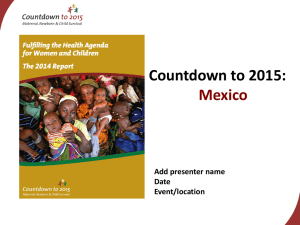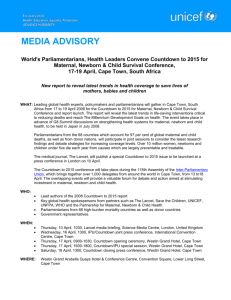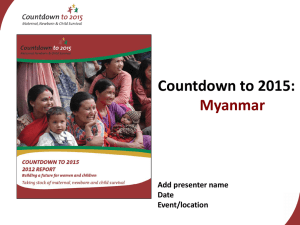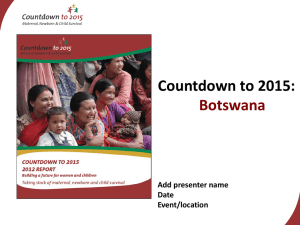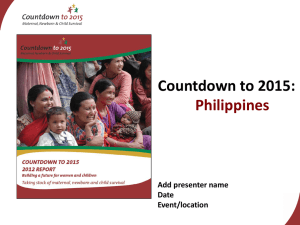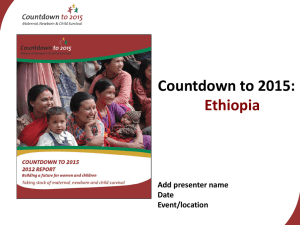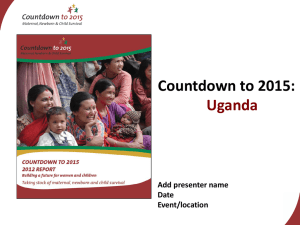Lack of Skilled Birth Care Costs 2 Million Lives
advertisement
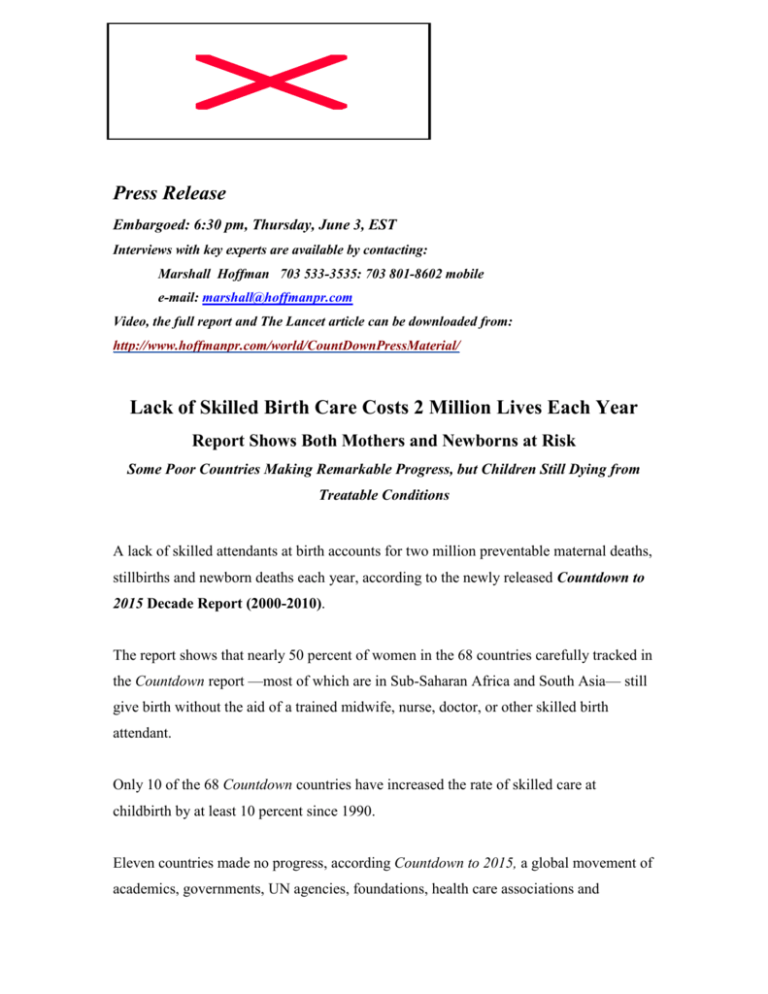
Press Release Embargoed: 6:30 pm, Thursday, June 3, EST Interviews with key experts are available by contacting: Marshall Hoffman 703 533-3535: 703 801-8602 mobile e-mail: marshall@hoffmanpr.com Video, the full report and The Lancet article can be downloaded from: http://www.hoffmanpr.com/world/CountDownPressMaterial/ Lack of Skilled Birth Care Costs 2 Million Lives Each Year Report Shows Both Mothers and Newborns at Risk Some Poor Countries Making Remarkable Progress, but Children Still Dying from Treatable Conditions A lack of skilled attendants at birth accounts for two million preventable maternal deaths, stillbirths and newborn deaths each year, according to the newly released Countdown to 2015 Decade Report (2000-2010). The report shows that nearly 50 percent of women in the 68 countries carefully tracked in the Countdown report —most of which are in Sub-Saharan Africa and South Asia— still give birth without the aid of a trained midwife, nurse, doctor, or other skilled birth attendant. Only 10 of the 68 Countdown countries have increased the rate of skilled care at childbirth by at least 10 percent since 1990. Eleven countries made no progress, according Countdown to 2015, a global movement of academics, governments, UN agencies, foundations, health care associations and nongovernmental organizations formed in 2005 to track progress in reducing maternal and child deaths in the 68 countries where over 95 percent of these deaths occur. “All women and their newborns need skilled care at birth and access to emergency care when complications develop,” says Zulfiqar A. Bhutta, MD, of the Aga Khan University, Karachi, Pakistan and co-chair of Countdown to 2015. “Skilled childbirth care is one crucial element of a continuum of care for women, newborns and children that can drastically reduce the toll of death and illness in the Countdown countries.” The global shortage of midwives is especially severe: an estimated 700,000 new midwives* and other trained providers are needed in order to provide skilled childbirth care to all women who need it. In Africa alone, an additional 1.5 million health workers are needed, nearly doubling the current workforce of 1.6 million, according to the Global Health Workforce Alliance. Some countries are doing well at providing skilled birth attendants. A skilled provider attends more than 75 percent of births in Azerbaijan, Tajikistan, Iraq, Egypt and Indonesia. Almost 100 percent of births are attended in Turkmenistan and China. Starting with very low skilled attendance coverage, many of the 68 Countdown countries have made major progress in providing women with a skilled attendant at birth, with Angola, Bhutan, Laos, Nepal, Peru, Burkina Faso, Pakistan, and Rwanda showing the most impressive gains. At the other extreme, 10 countries made no progress from 2000 to 2008 and several, notably Bolivia, Cote d’Ivoire, Liberia, Malawi, Nigeria, Somalia, Swaziland, and Zimbabwe, showed decreases in the use of skilled birth attendance. Countdown to 2015 Decade Report - 2 Still Huge Maternal and Child Deaths In the two years since the publication of the previous Countdown report, 19 million women and children under five have died because of preventable or treatable conditions. Pneumonia, diarrhea and malaria continue to kill more than three million children every year. Despite the availability of effective treatment for these diseases, half the children who need treatment do not receive it. Under nutrition contributes to more than a third of all child deaths, a clear indicator of the role of poverty in determining child health and well-being. Continuum of Care Saves Lives According to a decade of data, deaths of women around the time of childbirth, stillbirths, and deaths of newborns within their first 28 days are all closely linked. In addition to care by a skilled attendant, women and babies require high-quality care in the period just before, during and just after birth, when the risk of mortality is highest. These crucial services, part of a continuum of care that begins before pregnancy and extends through early childhood, include: The administration of oxytocin to prevent post-partum hemorrhage, the leading cause of maternal deaths. Services to prevent and treat birth complications if they develop. Tetanus immunization for mothers. Early initiation of breastfeeding. Postnatal visits including family planning and screening for maternal complications. Immunizations for babies. Countdown to 2015 Decade Report - 3 Bednets for protection against malaria. Antibiotics for pneumonia. “During this critical period of birth and the first few days of life, far more than 50 percent of maternal and newborn deaths can be prevented by the initiation of these simple interventions, as part of a continuum of care that links home and hospital,” says Joy Lawn, M.D., of Save the Children. “Many can be administered by trained community health workers or shifted to other carefully supervised workers.” Evidence from Bangladesh and Nepal, cited in the Countdown report, shows that implementing policies to permit community health workers to offer treatment for diarrhea and pneumonia – two leading killers of children – is effective in reducing child deaths. The data shows that survival of children under age 5 is also closely linked to maternal health. “When a mother dies, her newborn baby is unlikely to survive, and all of her children suffer,” says Dr. Lawn. A good news/bad news report The new report provides a mix of good and bad news. One good news message is that the under-5 child mortality rate has declined by 28 percent, from an estimated 90 deaths per 1000 live births in 1990 to 65 deaths per 1000 in 2008, accounting for a reduction of nearly 4 million child deaths per year. Nineteen of the 68 Countdown countries now are “on track” to meet Millennium Development Goal (MDG) 4, set by 189 member nations of the United Nations General Assembly in 2000, which calls for reducing child deaths by two-thirds between the 1990 base line and 2015. Countdown to 2015 Decade Report - 4 But that good news is balanced by the finding that most Countdown countries are not progressing fast enough, and many may not meet the 2015 deadline on reducing child deaths. New data also indicates that progress is being made globally on improving maternal health. However, most of the 68 Countdown countries will not meet MDG 5, the cutting maternal deaths by 75 percent from 1990 to 2015 and achieving universal access to reproductive health. Among the report’s most positive news is that some of the poorest countries in the world are making progress and reaching the most vulnerable with needed services. Some examples of progress include: India and Malawi now implement integrated community case management for pneumonia and other childhood illnesses, and several countries are deploying community health workers to address shortages and poor distribution of health care workers; Over 90 percent of C-sections in rural areas of Mozambique and Malawi now are performed successfully by trained surgical technicians, whose safety record is equal to that of obstetrician/gynecologists; Uganda increased coverage of essential health services, especially for the poor, by removing user fees; In Malawi, government-paid multi-purpose extension health workers, known as health surveillance assistants, assess and treat children for a range of conditions; Ghana recorded a sharp increase in births in health care facilities when a new health insurance plan and policies that guaranteed free care at birth went into effect; In Rwanda, a Pay for Performance program that provided financial incentives to providers to increase the use of health care facilities and improve the quality of care prompted an increase in births in health care facilities; Countdown to 2015 Decade Report - 5 India’s Women's Protection Scheme offers cash payments to women who attend antenatal appointments and give birth in a health facility. These payments are made primarily to women living in poverty; Madagascar’s Family Planning Program has resulted in considerable increases in the use of modern contraceptives by offering them free in all public health facilities; the program is accompanied by an awareness campaign and community involvement in the delivery of family planning services. Brazil’s success in reducing the under-5 death rate by 4.8 percent each year since 1990 is attributed to a sharp decline in inequalities in access to health care. This decline was accomplished through a nationwide, tax-based Unified Health System with no user fees and specific geographic targeting of family health teams to attend the poorest areas of the country. Primary care is free for everyone, and even the poorest Brazilians now have access to skilled attendance at birth. “The Countdown report’s mix of good news and bad news shows clearly that, even in areas where substantial advancements have been made, progress has been uneven,” says Elizabeth Mason, M.D., Director of Child and Adolescent Health at the World Health Organization (WHO). “By focusing on increasing coverage of proven interventions, there is still time to achieve the urgently important targets of MDGs 4 and 5.” Slow Progress in Reducing Neonatal Deaths Indicates Need for Mix of Strategies The report shows that while total under-5 child deaths have declined, the proportion of neonatal deaths (babies who die during their first 28 days of life) has increased from 37 percent in 2000-2003 to 41 percent of under-5 deaths. “Most of the progress is for the older child,” says Mickey Chopra, M.D., head of health for UNICEF. “That progress demonstrates that interventions for potential child killers such as measles and other vaccine-preventable diseases are being used effectively and are saving lives. Insecticide-treated bednets and prevention of maternal to child transmission Countdown to 2015 Decade Report - 6 of HIV have been rapidly scaled up in many countries. These successes show what can happen when commitments are made and fulfilled.” “Improving the survival rate of mothers and newborns calls for a mix of strategies that deal with women’s health and family planning, the delivery of quality antenatal, childbirth and postnatal care, and emergency obstetric care to respond to life-threatening complications in the mother or newborn baby. These same interventions save both mothers and babies.” says Flavia Bustreo, MD, director of the Partnership for Maternal, Newborn and Child Health. “It can be done. The Countdown report helps us understand how and why countries were able to achieve significant progress in the last decade" Family planning disparities Countdown data show that funding for family planning programs has declined since the 1990s and still falls far short of the need. Progress in improving coverage of family planning services has been modest and highly variable across the 68 Countdown countries. The gap between availability and need for contraceptive services is especially great in Chad, Eritrea, Sierra Leone, Mali, and Guinea. “The huge unmet need for family planning is a gap that must be filled,” says Laura Laski, MD, Chief of the Sexual and Reproductive Health Branch of the United Nations Population Fund (UNFPA). “Enabling women to control the number, timing, and spacing of their children, and to avoid unintended pregnancy, is one of the most effective means of reducing maternal and newborn deaths.” Equal Care for Women and Children Equity remains a significant problem, the report shows, and use of essential services is significantly higher among women and children from better-off families than among those from poorer families. The size of this equity gap varies, even in countries with similar overall levels of coverage. For example both Guatemala and Zambia have similar Countdown to 2015 Decade Report - 7 rates of coverage for many important health interventions, but in Guatemala only 38 percent of poor families receive an array of services while in Zambia, 55 percent of the poorest families are covered. “The disparities between rich and poor remain far too high, especially for the maternal and newborn health care services that need to be delivered in clinics or hospitals,” notes Ann Starrs, president of Family Care International. “To save the lives of women, newborns, and children, health services must reach the poor and marginalized communities where so many are dying.” Progress Needed on Health Policies and Financing The report shows that too few countries have adopted evidence-based policies to increase access to and quality of essential maternal, newborn and child health services, but there has been important progress. As of 2010, for example, 29 countries have instituted policies that allow community health workers to provide such services as antibiotics to treat pneumonia, up from only 18 countries in 2008. Funding remains a serious problem. Only 5 of the Countdown countries allocate 15 percent or more of their national budgets to health, and in only five countries are household out-of-pocket expenditures for health less than 15 percent of total health spending. “The median per capita health expenditure in 2007 in the 68 Countdown countries was 80 international dollars for all health care, which is very little compared to the thousands of dollars spent in advanced countries,” says Peter Berman, the lead health economist of The World Bank. Countdown’s figures show that development aid for maternal and child health has increased over the past 5 years, although it remains inadequate overall – only 31 percent of development aid for health was directed to programs for women, newborns, and Countdown to 2015 Decade Report - 8 children. The Countdown data shows that this money often is not targeted to the poorest countries or nations with the greatest mortality burdens. By tracking problems and progress in Countdown countries, the 2010 Decade Report shows how some countries have prioritized maternal, newborn and child health and used limited resources more effectively to make progress toward meeting the health-related MDGs * * * The Countdown Website address: www.countdown2015mnch.org * Strengthening Midwifery: Saving Lives and Promoting Health of Women and Newborns On the weekend of 5-6th June, in the lead up to Women Deliver Conference, a global Symposium on Strengthening Midwifery will take place at The Walter E. Washington Convention Center, Washington, DC. It will bring together 200 midwives from around the world, UN agencies, civil society, policy makers and donors. The primary aim is to build the consensus required to make a fundamental push for investments in strengthened midwifery services, as a way to improve maternal and newborn health. A press conference presenting the outcome will take place at the Conference Center at 3.30pm Monday 7th June. If you would like to interview participants, including midwives from around the world, please contact Jessica Malter, malter@unfpa.org, +1 646 732 0047 Countdown to 2015 Decade Report - 9 Countdown to 2015 Decade Report - 10
